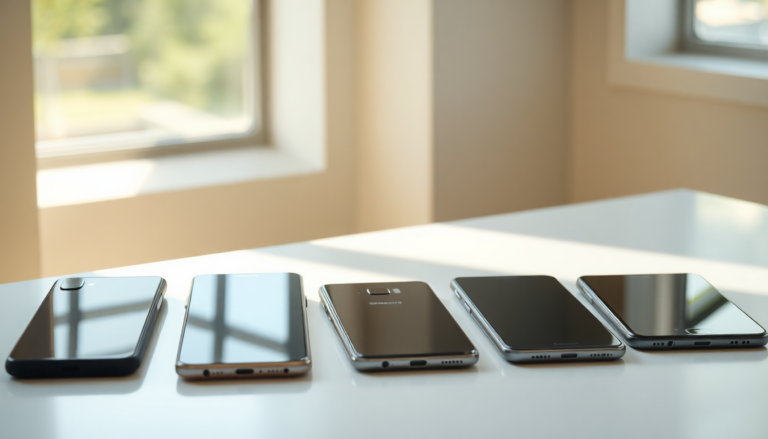Argomenti trattati
The world of Android smartphones is ever-evolving, with new models boasting cutting-edge technology that often seems to leap right out of a sci-fi movie. Recently, I found myself caught up in the excitement of testing some of the latest offerings from big players like Samsung and Google. These devices are not just about flashy features; they aim to deliver a seamless user experience that integrates innovation with practicality. From powerful processors to impressive camera systems, the latest Android phones are pushing the boundaries of what we can expect from our handheld devices.
Samsung Galaxy S25: The powerhouse of the lineup
The Samsung Galaxy S25 has quickly established itself as a standout model in the Android ecosystem. Priced at $800, it offers a battery life that can easily last over a day, which is a breath of fresh air in a market where many devices struggle to make it through the day. But what really sets the S25 apart is its longevity—Samsung has committed to providing seven years of major Android updates. That’s not just a promise; it’s a game-changer for users who want longevity in their devices.
While some might argue that the camera features are merely decent, the addition of a 3x telephoto lens for zooming is a welcome upgrade. I remember the days when zoom capabilities were a luxury, but now they’re becoming standard in flagship models. And let’s not forget about the AI features. Some of them, like Circle to Search, are genuinely useful, while others feel a bit gimmicky. Still, Samsung’s commitment to integrating AI into their devices is commendable.
Google Pixel 9A: Value meets performance
If you’re looking for something that doesn’t break the bank, the Google Pixel 9A might just be your best bet. At $499, it packs a punch with significant upgrades over its predecessor. The new design and enhanced battery life are particularly noteworthy. I was genuinely impressed by how it managed to deliver a high-quality experience while keeping the price under $500. It’s a perfect choice for anyone who wants the essence of a high-end phone without the extravagant price tag.
Of course, there are compromises—like the absence of satellite connectivity for emergencies that the more expensive Pixel 9 offers. But those sacrifices feel justified when you consider the overall performance and user experience. It handles daily tasks like a champ, from social media scrolling to capturing stunning photos. Personally, I believe that the Pixel 9A exemplifies what budget smartphones can achieve without sacrificing essential features.
Samsung Galaxy S25 Ultra: The ultimate flagship experience
For those who crave the absolute best, the Samsung Galaxy S25 Ultra is a sight to behold, though it comes at a steep price of $1,300. This device delivers an outstanding screen and camera quality that truly sets it apart from its siblings. It’s designed for those who demand more from their smartphones—whether it’s for professional photography or high-end gaming. The S25 Ultra doesn’t just perform; it excels.
While the price tag may deter some, the Ultra’s features, like the new Snapdragon 8 Elite processor and advanced camera settings, make it a worthwhile investment for serious tech enthusiasts. The added functionalities, such as enhanced video tools that rival the iPhone 16 Pro, solidify its place at the top of the smartphone food chain. If you’re already using a Galaxy S22 Ultra, you might find the upgrade to be less compelling unless you’re particularly drawn to the new features.
Motorola Razr Ultra: A unique folding experience
Then there’s the Motorola Razr Ultra, a foldable phone that feels like a fresh take on the traditional smartphone design. Priced at $1,300, it combines the nostalgia of flip phones with modern technology. During my tests, I found that the unique cover screen added a layer of convenience that I didn’t expect. It allows for quick interactions without having to unfold the device. However, the Razr Ultra does face some stiff competition, especially when considering its price point.
While the build quality is impressive and the battery life is commendable, the Razr Ultra’s position in the market might be precarious given the growing popularity of traditional flagship models. It’s an exciting device, but its appeal may be limited to those who truly appreciate the foldable form factor.
What to consider when choosing a new Android phone
As you navigate the world of Android smartphones, keep in mind that not all devices are created equal. Your choice should depend on various factors, including your budget, the features you prioritize, and whether you’re looking for something cutting-edge or a reliable workhorse. It’s easy to get lost in the specs, but the best advice I can offer is to think about how you’ll actually use the phone in daily life. Will you be taking tons of photos? Streaming videos? Or maybe you just need a solid device for calls and texts?
With options ranging from budget-friendly to top-tier flagships, there’s something for everyone in the Android realm. And with companies like Google and Samsung leading the charge, innovation is likely to continue shaping the way we interact with technology. The future looks bright, and I can’t wait to see what comes next.
Final thoughts on the Android smartphone landscape
In the end, the Android smartphone landscape is more vibrant than ever. Whether you’re looking for a device that offers exceptional value or a flagship with all the bells and whistles, you’ll find no shortage of options. As I reflect on my experiences testing these devices, I am continually impressed by the strides manufacturers are making in terms of technology and user experience. It makes me excited for what’s around the corner. If I had to choose, I’d say that the best Android phone is the one that meets your specific needs—after all, that’s what truly defines a great smartphone.

